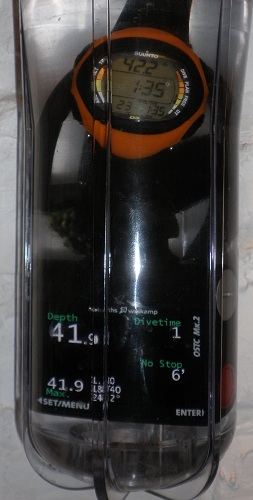One of the problems with programming dive computers is testing the things. You can provide a 'dive simulator' mode to feed the right values into the maths and test the functions that use depth and time but you would really like to run things as a system sometimes. Here is my diving simulator.
The main element is a Fulflo LT filter housing from RS online. It has a maximum working pressure of 10 bar and room for a nice big filter, which I do not need. This gives me a 70mm diameter by 200mm long working volume with standard 3/4" BSPP fittings sat on my desk for about 50 quid. I rummaged the fittings out of the spares bin and put an adapter to my big low pressure air tools compressor on it so I can blow it straight down to 80 meters. The label FRONT is just there to remind me which side is facing forwards when it is done up and ready to dive so I can read the displays not have them facing the wall.
I put a cheap air tool regulator valve on the input so I can wind it down and a needle valve on the output which is set to bleed gently during a dive so it comes up when I start to close the regulator again. I find I can adjust to within 10cms of a required depth quite easily although it doesn't want to start gently as the regulator doesn't like to do small fractions of a bar very well.
The pictures show my free diving Suunto D3 and the OSTC2 on its standard software at four and a bit bar. Having a see through front means I can follow a deco profile on the computer as it commands and then, après dive, dump out the recording to see why it made those recommendations. The only thing I can't do is push the buttons.
Incidentally I always run it virtually full of water so if something breaks there isn't much expansion that can happen. You can probably see the water level just behind the FRONT label. The energy in a compressed system almost all resides in compressable materials so if it breaks with lots of gas it goes bang big time propelling bits about at speed. With very little gas in it it would just go pop - hiss and leak water all over my floor.


 The first job was to compile the supplied open source code. It was OK but it
wasn't really my style. My style has been built up working on military and
aviation equipment over the years so I'm bound to be a bit picky. Working on
life support is one thing but, when you get down to it, the guys who are paying
for death support raise the stakes a further notch. Their stuff isn't
accidentally dangerous it is very deliberatly dangerous and they want it
targetted on the bad guys not the good guys. So I took the supplied code as a
guide but, any way, I'd prefer to start from scratch so it's all my fault when
it goes wrong on me.
The first job was to compile the supplied open source code. It was OK but it
wasn't really my style. My style has been built up working on military and
aviation equipment over the years so I'm bound to be a bit picky. Working on
life support is one thing but, when you get down to it, the guys who are paying
for death support raise the stakes a further notch. Their stuff isn't
accidentally dangerous it is very deliberatly dangerous and they want it
targetted on the bad guys not the good guys. So I took the supplied code as a
guide but, any way, I'd prefer to start from scratch so it's all my fault when
it goes wrong on me. Then there was onto the whole problem of making standardised interfaces for my
pages. I wanted a system that meant that each page went in its own source file,
it had a standard start, refresh, two buttons and an end function so I just
provided a list of pages, it started on page one and everything worked from
there. Each page decided what pages it would link too and normally, if you
didn't do anything for about forty seconds (configurable naturally), it would
just take you back to page one.
Then there was onto the whole problem of making standardised interfaces for my
pages. I wanted a system that meant that each page went in its own source file,
it had a standard start, refresh, two buttons and an end function so I just
provided a list of pages, it started on page one and everything worked from
there. Each page decided what pages it would link too and normally, if you
didn't do anything for about forty seconds (configurable naturally), it would
just take you back to page one.